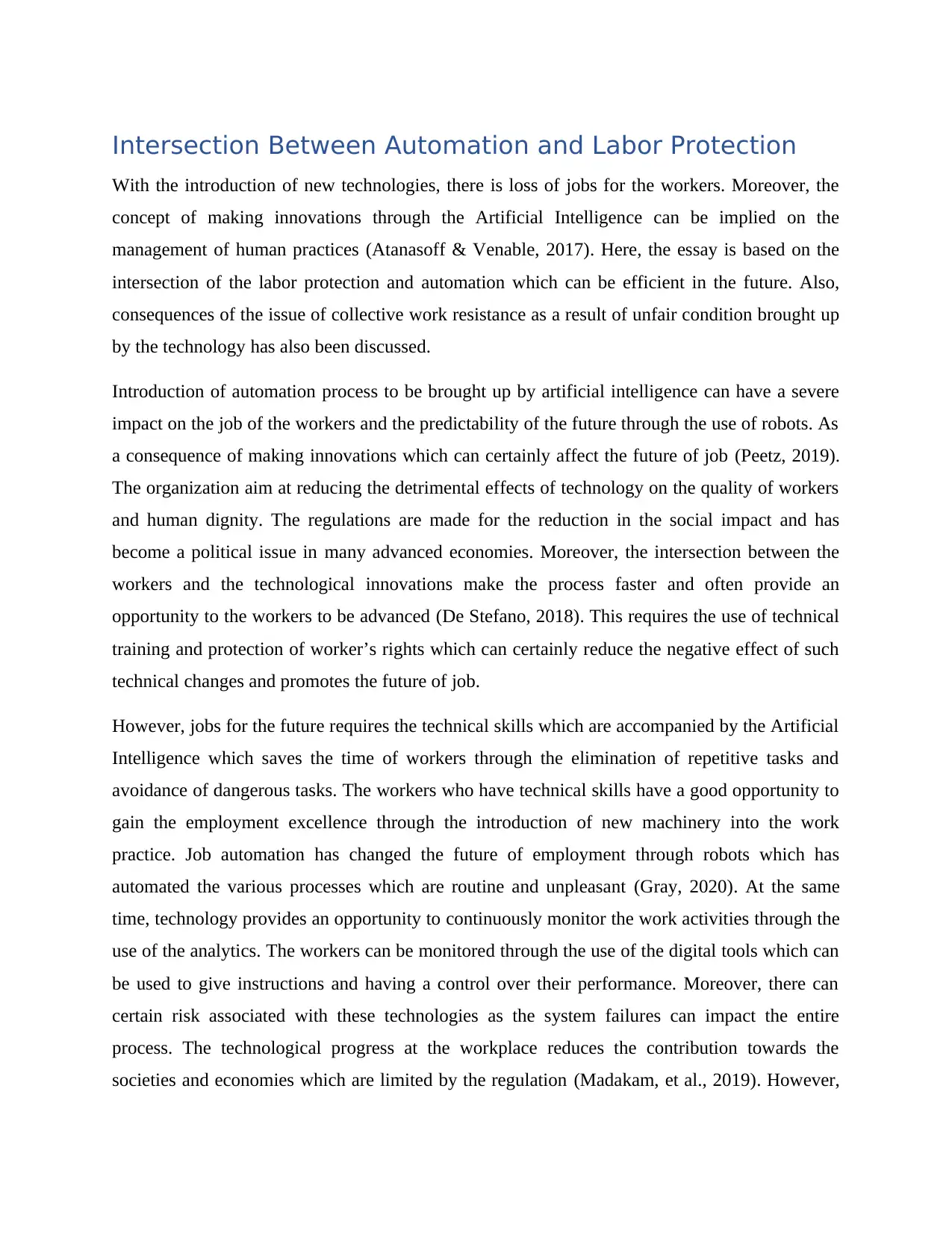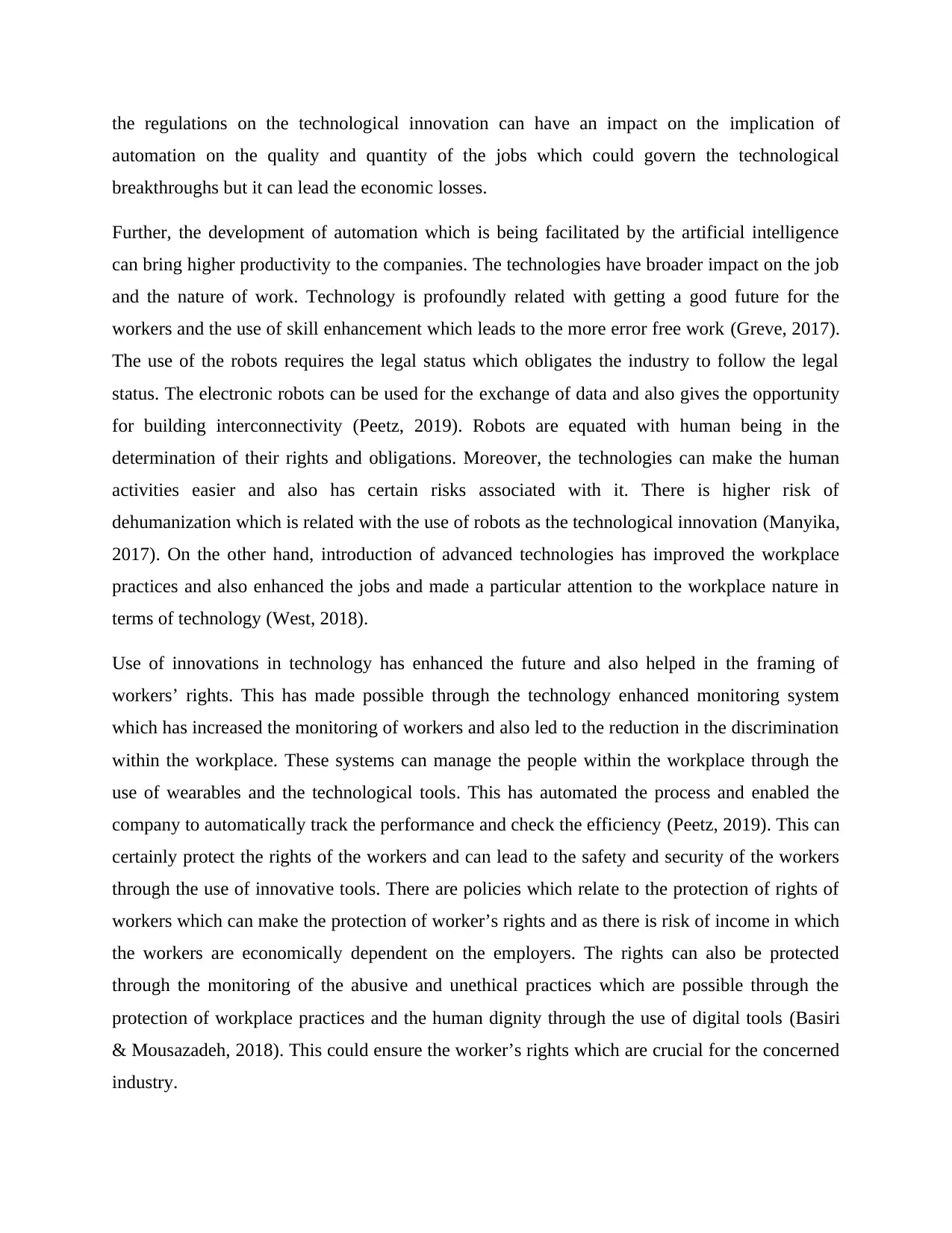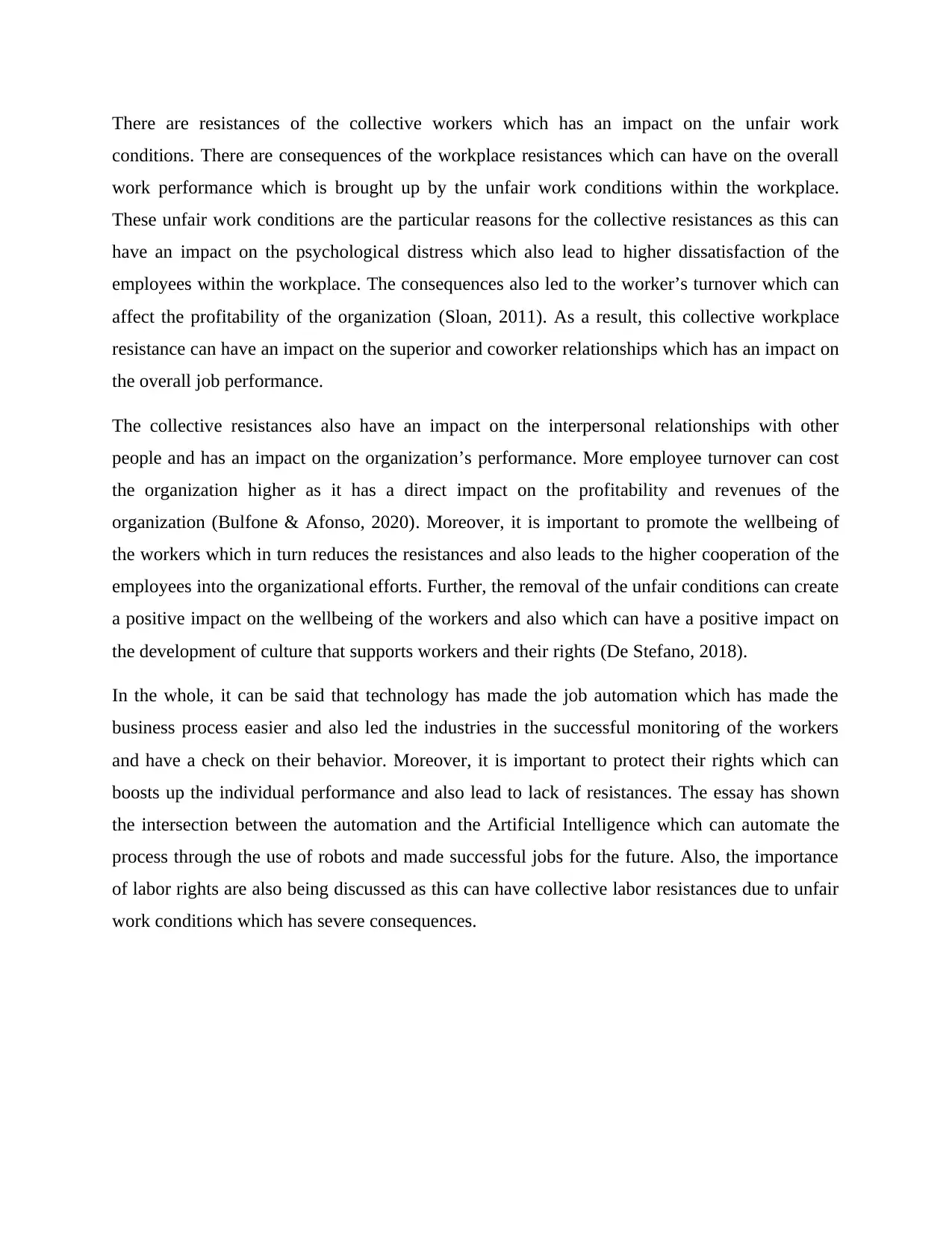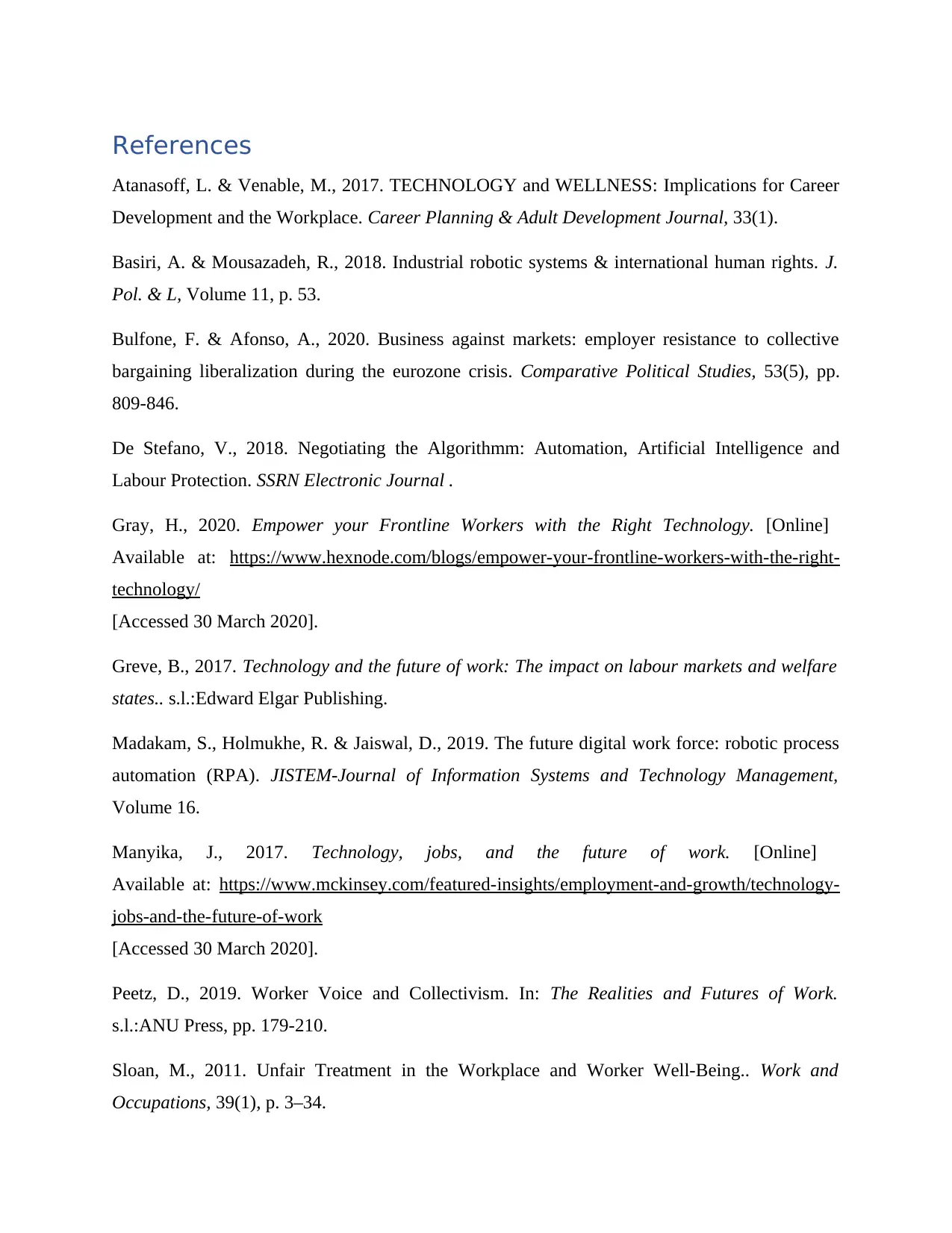Analyzing the Intersection of Automation, Work Rights, and AI
VerifiedAdded on 2022/09/07
|6
|1667
|16
Essay
AI Summary
This essay examines the critical intersection between automation, artificial intelligence (AI), and work rights. It explores the impact of new technologies on job displacement and the evolving nature of work, highlighting the role of AI in both streamlining human practices and potentially disrupting them. The essay delves into the consequences of automation, including the potential for collective work resistance due to unfair conditions. It also discusses the importance of worker protection, technical training, and the need for regulations to mitigate the negative social and economic impacts of automation. The analysis covers various aspects, such as the use of digital tools for monitoring workers, the importance of protecting worker rights, and the consequences of unfair working conditions on employee well-being and organizational performance. The essay concludes by emphasizing the need to balance technological advancements with the protection of worker rights to foster a productive and equitable work environment.

RUNNING HEAD: WORK RIGHTS AND WORK-LIFE BALANCE 0
2020
Work Rights and Work-Life Balance
Student’s Details-
2020
Work Rights and Work-Life Balance
Student’s Details-
Paraphrase This Document
Need a fresh take? Get an instant paraphrase of this document with our AI Paraphraser

Intersection Between Automation and Labor Protection
With the introduction of new technologies, there is loss of jobs for the workers. Moreover, the
concept of making innovations through the Artificial Intelligence can be implied on the
management of human practices (Atanasoff & Venable, 2017). Here, the essay is based on the
intersection of the labor protection and automation which can be efficient in the future. Also,
consequences of the issue of collective work resistance as a result of unfair condition brought up
by the technology has also been discussed.
Introduction of automation process to be brought up by artificial intelligence can have a severe
impact on the job of the workers and the predictability of the future through the use of robots. As
a consequence of making innovations which can certainly affect the future of job (Peetz, 2019).
The organization aim at reducing the detrimental effects of technology on the quality of workers
and human dignity. The regulations are made for the reduction in the social impact and has
become a political issue in many advanced economies. Moreover, the intersection between the
workers and the technological innovations make the process faster and often provide an
opportunity to the workers to be advanced (De Stefano, 2018). This requires the use of technical
training and protection of worker’s rights which can certainly reduce the negative effect of such
technical changes and promotes the future of job.
However, jobs for the future requires the technical skills which are accompanied by the Artificial
Intelligence which saves the time of workers through the elimination of repetitive tasks and
avoidance of dangerous tasks. The workers who have technical skills have a good opportunity to
gain the employment excellence through the introduction of new machinery into the work
practice. Job automation has changed the future of employment through robots which has
automated the various processes which are routine and unpleasant (Gray, 2020). At the same
time, technology provides an opportunity to continuously monitor the work activities through the
use of the analytics. The workers can be monitored through the use of the digital tools which can
be used to give instructions and having a control over their performance. Moreover, there can
certain risk associated with these technologies as the system failures can impact the entire
process. The technological progress at the workplace reduces the contribution towards the
societies and economies which are limited by the regulation (Madakam, et al., 2019). However,
With the introduction of new technologies, there is loss of jobs for the workers. Moreover, the
concept of making innovations through the Artificial Intelligence can be implied on the
management of human practices (Atanasoff & Venable, 2017). Here, the essay is based on the
intersection of the labor protection and automation which can be efficient in the future. Also,
consequences of the issue of collective work resistance as a result of unfair condition brought up
by the technology has also been discussed.
Introduction of automation process to be brought up by artificial intelligence can have a severe
impact on the job of the workers and the predictability of the future through the use of robots. As
a consequence of making innovations which can certainly affect the future of job (Peetz, 2019).
The organization aim at reducing the detrimental effects of technology on the quality of workers
and human dignity. The regulations are made for the reduction in the social impact and has
become a political issue in many advanced economies. Moreover, the intersection between the
workers and the technological innovations make the process faster and often provide an
opportunity to the workers to be advanced (De Stefano, 2018). This requires the use of technical
training and protection of worker’s rights which can certainly reduce the negative effect of such
technical changes and promotes the future of job.
However, jobs for the future requires the technical skills which are accompanied by the Artificial
Intelligence which saves the time of workers through the elimination of repetitive tasks and
avoidance of dangerous tasks. The workers who have technical skills have a good opportunity to
gain the employment excellence through the introduction of new machinery into the work
practice. Job automation has changed the future of employment through robots which has
automated the various processes which are routine and unpleasant (Gray, 2020). At the same
time, technology provides an opportunity to continuously monitor the work activities through the
use of the analytics. The workers can be monitored through the use of the digital tools which can
be used to give instructions and having a control over their performance. Moreover, there can
certain risk associated with these technologies as the system failures can impact the entire
process. The technological progress at the workplace reduces the contribution towards the
societies and economies which are limited by the regulation (Madakam, et al., 2019). However,

the regulations on the technological innovation can have an impact on the implication of
automation on the quality and quantity of the jobs which could govern the technological
breakthroughs but it can lead the economic losses.
Further, the development of automation which is being facilitated by the artificial intelligence
can bring higher productivity to the companies. The technologies have broader impact on the job
and the nature of work. Technology is profoundly related with getting a good future for the
workers and the use of skill enhancement which leads to the more error free work (Greve, 2017).
The use of the robots requires the legal status which obligates the industry to follow the legal
status. The electronic robots can be used for the exchange of data and also gives the opportunity
for building interconnectivity (Peetz, 2019). Robots are equated with human being in the
determination of their rights and obligations. Moreover, the technologies can make the human
activities easier and also has certain risks associated with it. There is higher risk of
dehumanization which is related with the use of robots as the technological innovation (Manyika,
2017). On the other hand, introduction of advanced technologies has improved the workplace
practices and also enhanced the jobs and made a particular attention to the workplace nature in
terms of technology (West, 2018).
Use of innovations in technology has enhanced the future and also helped in the framing of
workers’ rights. This has made possible through the technology enhanced monitoring system
which has increased the monitoring of workers and also led to the reduction in the discrimination
within the workplace. These systems can manage the people within the workplace through the
use of wearables and the technological tools. This has automated the process and enabled the
company to automatically track the performance and check the efficiency (Peetz, 2019). This can
certainly protect the rights of the workers and can lead to the safety and security of the workers
through the use of innovative tools. There are policies which relate to the protection of rights of
workers which can make the protection of worker’s rights and as there is risk of income in which
the workers are economically dependent on the employers. The rights can also be protected
through the monitoring of the abusive and unethical practices which are possible through the
protection of workplace practices and the human dignity through the use of digital tools (Basiri
& Mousazadeh, 2018). This could ensure the worker’s rights which are crucial for the concerned
industry.
automation on the quality and quantity of the jobs which could govern the technological
breakthroughs but it can lead the economic losses.
Further, the development of automation which is being facilitated by the artificial intelligence
can bring higher productivity to the companies. The technologies have broader impact on the job
and the nature of work. Technology is profoundly related with getting a good future for the
workers and the use of skill enhancement which leads to the more error free work (Greve, 2017).
The use of the robots requires the legal status which obligates the industry to follow the legal
status. The electronic robots can be used for the exchange of data and also gives the opportunity
for building interconnectivity (Peetz, 2019). Robots are equated with human being in the
determination of their rights and obligations. Moreover, the technologies can make the human
activities easier and also has certain risks associated with it. There is higher risk of
dehumanization which is related with the use of robots as the technological innovation (Manyika,
2017). On the other hand, introduction of advanced technologies has improved the workplace
practices and also enhanced the jobs and made a particular attention to the workplace nature in
terms of technology (West, 2018).
Use of innovations in technology has enhanced the future and also helped in the framing of
workers’ rights. This has made possible through the technology enhanced monitoring system
which has increased the monitoring of workers and also led to the reduction in the discrimination
within the workplace. These systems can manage the people within the workplace through the
use of wearables and the technological tools. This has automated the process and enabled the
company to automatically track the performance and check the efficiency (Peetz, 2019). This can
certainly protect the rights of the workers and can lead to the safety and security of the workers
through the use of innovative tools. There are policies which relate to the protection of rights of
workers which can make the protection of worker’s rights and as there is risk of income in which
the workers are economically dependent on the employers. The rights can also be protected
through the monitoring of the abusive and unethical practices which are possible through the
protection of workplace practices and the human dignity through the use of digital tools (Basiri
& Mousazadeh, 2018). This could ensure the worker’s rights which are crucial for the concerned
industry.
⊘ This is a preview!⊘
Do you want full access?
Subscribe today to unlock all pages.

Trusted by 1+ million students worldwide

There are resistances of the collective workers which has an impact on the unfair work
conditions. There are consequences of the workplace resistances which can have on the overall
work performance which is brought up by the unfair work conditions within the workplace.
These unfair work conditions are the particular reasons for the collective resistances as this can
have an impact on the psychological distress which also lead to higher dissatisfaction of the
employees within the workplace. The consequences also led to the worker’s turnover which can
affect the profitability of the organization (Sloan, 2011). As a result, this collective workplace
resistance can have an impact on the superior and coworker relationships which has an impact on
the overall job performance.
The collective resistances also have an impact on the interpersonal relationships with other
people and has an impact on the organization’s performance. More employee turnover can cost
the organization higher as it has a direct impact on the profitability and revenues of the
organization (Bulfone & Afonso, 2020). Moreover, it is important to promote the wellbeing of
the workers which in turn reduces the resistances and also leads to the higher cooperation of the
employees into the organizational efforts. Further, the removal of the unfair conditions can create
a positive impact on the wellbeing of the workers and also which can have a positive impact on
the development of culture that supports workers and their rights (De Stefano, 2018).
In the whole, it can be said that technology has made the job automation which has made the
business process easier and also led the industries in the successful monitoring of the workers
and have a check on their behavior. Moreover, it is important to protect their rights which can
boosts up the individual performance and also lead to lack of resistances. The essay has shown
the intersection between the automation and the Artificial Intelligence which can automate the
process through the use of robots and made successful jobs for the future. Also, the importance
of labor rights are also being discussed as this can have collective labor resistances due to unfair
work conditions which has severe consequences.
conditions. There are consequences of the workplace resistances which can have on the overall
work performance which is brought up by the unfair work conditions within the workplace.
These unfair work conditions are the particular reasons for the collective resistances as this can
have an impact on the psychological distress which also lead to higher dissatisfaction of the
employees within the workplace. The consequences also led to the worker’s turnover which can
affect the profitability of the organization (Sloan, 2011). As a result, this collective workplace
resistance can have an impact on the superior and coworker relationships which has an impact on
the overall job performance.
The collective resistances also have an impact on the interpersonal relationships with other
people and has an impact on the organization’s performance. More employee turnover can cost
the organization higher as it has a direct impact on the profitability and revenues of the
organization (Bulfone & Afonso, 2020). Moreover, it is important to promote the wellbeing of
the workers which in turn reduces the resistances and also leads to the higher cooperation of the
employees into the organizational efforts. Further, the removal of the unfair conditions can create
a positive impact on the wellbeing of the workers and also which can have a positive impact on
the development of culture that supports workers and their rights (De Stefano, 2018).
In the whole, it can be said that technology has made the job automation which has made the
business process easier and also led the industries in the successful monitoring of the workers
and have a check on their behavior. Moreover, it is important to protect their rights which can
boosts up the individual performance and also lead to lack of resistances. The essay has shown
the intersection between the automation and the Artificial Intelligence which can automate the
process through the use of robots and made successful jobs for the future. Also, the importance
of labor rights are also being discussed as this can have collective labor resistances due to unfair
work conditions which has severe consequences.
Paraphrase This Document
Need a fresh take? Get an instant paraphrase of this document with our AI Paraphraser

References
Atanasoff, L. & Venable, M., 2017. TECHNOLOGY and WELLNESS: Implications for Career
Development and the Workplace. Career Planning & Adult Development Journal, 33(1).
Basiri, A. & Mousazadeh, R., 2018. Industrial robotic systems & international human rights. J.
Pol. & L, Volume 11, p. 53.
Bulfone, F. & Afonso, A., 2020. Business against markets: employer resistance to collective
bargaining liberalization during the eurozone crisis. Comparative Political Studies, 53(5), pp.
809-846.
De Stefano, V., 2018. Negotiating the Algorithmm: Automation, Artificial Intelligence and
Labour Protection. SSRN Electronic Journal .
Gray, H., 2020. Empower your Frontline Workers with the Right Technology. [Online]
Available at: https://www.hexnode.com/blogs/empower-your-frontline-workers-with-the-right-
technology/
[Accessed 30 March 2020].
Greve, B., 2017. Technology and the future of work: The impact on labour markets and welfare
states.. s.l.:Edward Elgar Publishing.
Madakam, S., Holmukhe, R. & Jaiswal, D., 2019. The future digital work force: robotic process
automation (RPA). JISTEM-Journal of Information Systems and Technology Management,
Volume 16.
Manyika, J., 2017. Technology, jobs, and the future of work. [Online]
Available at: https://www.mckinsey.com/featured-insights/employment-and-growth/technology-
jobs-and-the-future-of-work
[Accessed 30 March 2020].
Peetz, D., 2019. Worker Voice and Collectivism. In: The Realities and Futures of Work.
s.l.:ANU Press, pp. 179-210.
Sloan, M., 2011. Unfair Treatment in the Workplace and Worker Well-Being.. Work and
Occupations, 39(1), p. 3–34.
Atanasoff, L. & Venable, M., 2017. TECHNOLOGY and WELLNESS: Implications for Career
Development and the Workplace. Career Planning & Adult Development Journal, 33(1).
Basiri, A. & Mousazadeh, R., 2018. Industrial robotic systems & international human rights. J.
Pol. & L, Volume 11, p. 53.
Bulfone, F. & Afonso, A., 2020. Business against markets: employer resistance to collective
bargaining liberalization during the eurozone crisis. Comparative Political Studies, 53(5), pp.
809-846.
De Stefano, V., 2018. Negotiating the Algorithmm: Automation, Artificial Intelligence and
Labour Protection. SSRN Electronic Journal .
Gray, H., 2020. Empower your Frontline Workers with the Right Technology. [Online]
Available at: https://www.hexnode.com/blogs/empower-your-frontline-workers-with-the-right-
technology/
[Accessed 30 March 2020].
Greve, B., 2017. Technology and the future of work: The impact on labour markets and welfare
states.. s.l.:Edward Elgar Publishing.
Madakam, S., Holmukhe, R. & Jaiswal, D., 2019. The future digital work force: robotic process
automation (RPA). JISTEM-Journal of Information Systems and Technology Management,
Volume 16.
Manyika, J., 2017. Technology, jobs, and the future of work. [Online]
Available at: https://www.mckinsey.com/featured-insights/employment-and-growth/technology-
jobs-and-the-future-of-work
[Accessed 30 March 2020].
Peetz, D., 2019. Worker Voice and Collectivism. In: The Realities and Futures of Work.
s.l.:ANU Press, pp. 179-210.
Sloan, M., 2011. Unfair Treatment in the Workplace and Worker Well-Being.. Work and
Occupations, 39(1), p. 3–34.

West, D., 2018. The future of work: robots, AI, and automation. s.l.:Brookings Institution Press.
⊘ This is a preview!⊘
Do you want full access?
Subscribe today to unlock all pages.

Trusted by 1+ million students worldwide
1 out of 6
Related Documents
Your All-in-One AI-Powered Toolkit for Academic Success.
+13062052269
info@desklib.com
Available 24*7 on WhatsApp / Email
![[object Object]](/_next/static/media/star-bottom.7253800d.svg)
Unlock your academic potential
Copyright © 2020–2025 A2Z Services. All Rights Reserved. Developed and managed by ZUCOL.





